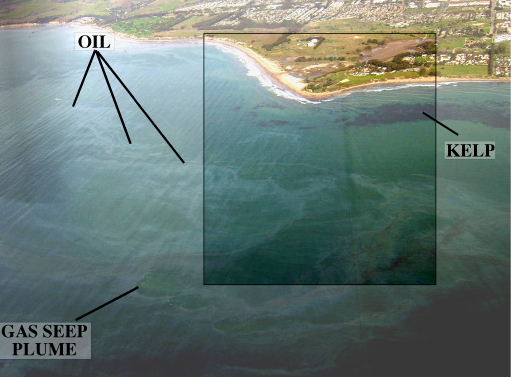|
OIL SLICKS IN THE
OCEAN: PREDICTING
THEIR RELEASE POINTS USING THE NATURAL LABORATORY OF THE SANTA
BARBARA CHANNEL
Principal Investigators:
Jordan Clark (UCSB), Bruce Luyendyk (UCSB),
and
Ira
Leifer (UCSB)
Summary of Research
 The main purpose of the project is to understand the role
played by seep bubbles in the transport of hydrocarbons including oil
from the seabed to the sea surface. The goal is to validate a numerical
bubble model to better predict the surfacing footprint of oil, thereby
improving spill mediation efforts and preparedness. The main purpose of the project is to understand the role
played by seep bubbles in the transport of hydrocarbons including oil
from the seabed to the sea surface. The goal is to validate a numerical
bubble model to better predict the surfacing footprint of oil, thereby
improving spill mediation efforts and preparedness.
Numerical studies showed sensitivity to several
parameters, including size, seep depth, upwelling flows, and saturation
of the plume water. Since these parameters are largely unknown in the
literature, our approach has been to measure these parameters at a very
active seep site, Shane Seep, as well as at several other seeps in the
seep field. In the process several discoveries were made.
Bubble Measurements
Measurements of the size distribution at the seabed are
used to initialize bubble models and thus are highly critical. Bubble
distributions were measured at the seabed at Shane Seep and published
in Leifer and Boles (2004). They showed that seeps can be loosely
classified into four categories, major, minor, obstructed, and elastic.
Elastic vents were observed at Ira Seep, a tar mound that transiently
released very large pulses of bubbles, with bubbles up to 20 cm
diameter. Obstructed seeps are where a vent is obstructed physically,
such as by a log or anemones, and tended to have very large bubbles.
Minor vents produce bubble streams at a low enough flow rate that the
size distribution is very narrow, and were in the size range of
2000-3500 µm radius. Major vents produced bubble flows
sufficiently strong that bubble breakup occurs, and have a broad and
weakly size dependent bubble size distribution.
Fluid Motions
Dye release experiments had quantified upwelling
velocities in the plume and provided dramatic evidence of the existence
of the upwelling flow. From the bubble distributions, upwelling
velocities were inferred for different bubble streams and are published
in Leifer and Boles (2004). Direct measurements of fluid motions by dye
releases are published in Clark et al. (2003) and were ~30 cm/s for
Shane Seep.
Seabed Morphology
During the last few years, numerous changes were observed
in the seabed morphology and in areas of active seepage (i.e., vent
activation and deactivation, crater growth and shrinking). These
changes were identified as related to transient seepage events that
were observed both directly and through air pollution records. A theory
on the effect of tar on gas seepage was developed from these
observations. Changes in the seabed features and the theory were
published in Leifer et al. (2004a).
Oil Emissions
Bubble distributions and upwelling flows were analyzed
and interpreted and showed a variability that could not be explained
absent bubble oiliness. It was discovered that at major vents, very oil
bubbles would occasionally be produced by the breakup of large bubbles.
These bubble-oil droplets rose very slowly, following a different
trajectory than the vast majority of bubbles. From minor vents,
occasional very oily bubbles escaped from the vent mouth. It was
believed that a 4 hz oscillation in bubble emission resulted from the
interaction between oil and gas flow through the vents, resulting in a
cyclical variation in oil/gas ratio. These results were published in
Leifer and Boles (2004).
Geochemistry
Gas samples collected and analyzed have suggested that
Shane Seep emissions have an unusually high CO2 concentration
(~12%). Measurements were then made of the CO2 profile in the
first 3 m above the seabed, and showed a rapid exponential decrease.
Surface bubble gas composition was measured for deeper (70 m) and
shallower (20 m) seeps and showed more air content at the deeper seeps.
Water concentrations were also measured in the bubble plumes at the
deeper and shallower seeps. Deeper seeps showed super saturations not
measured at the shallower seeps. This was interpreted as the the bubble
stream in water column had not had sufficient time to reach equilibrium
with only 20 m water, but did reach saturation in 70 m water. These
results were published in Clark et al. (2003).
|
[homepage]
|
[overview]
|
[researchers]
| [students
& staff]
|
[research] | [download reports]
|
|

